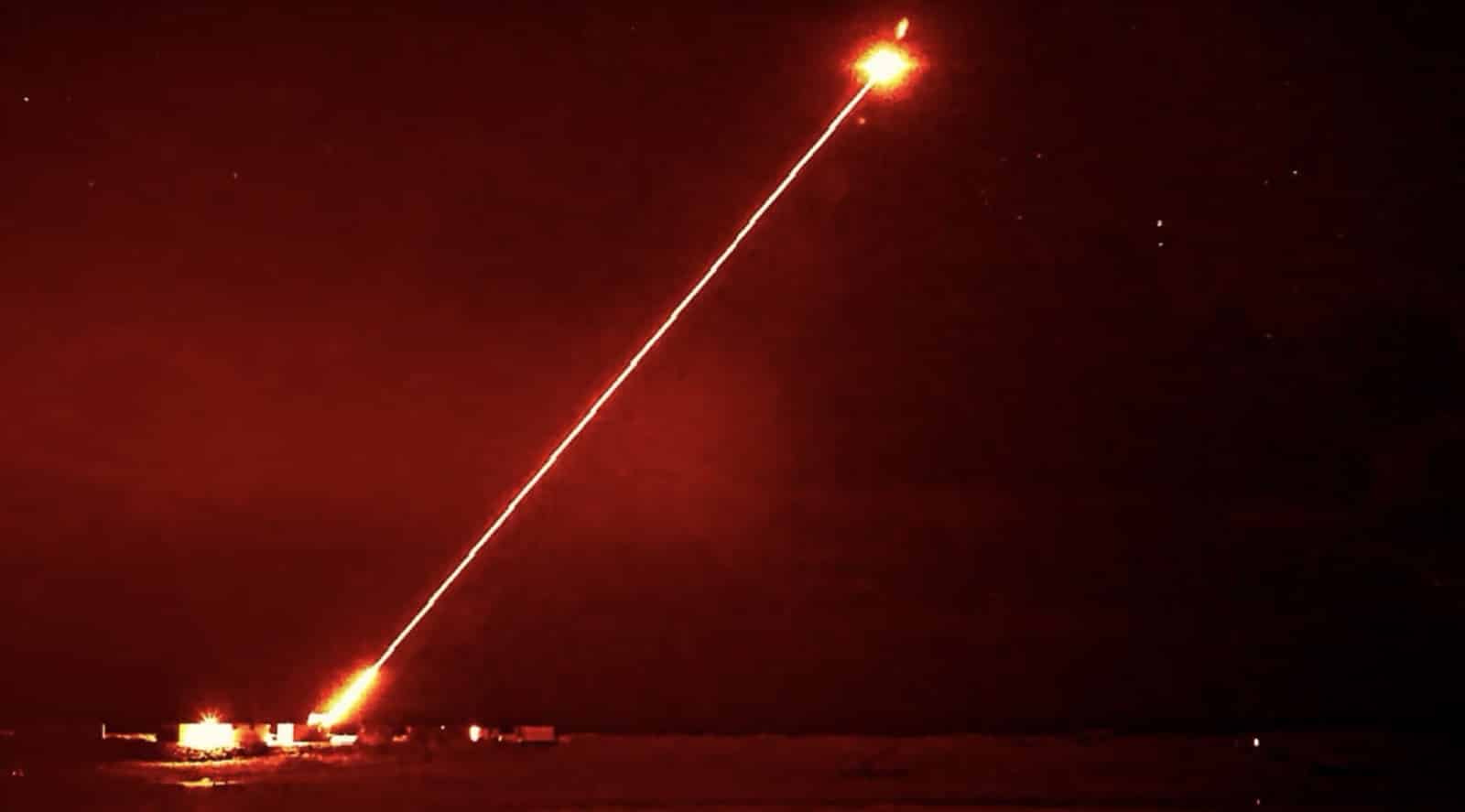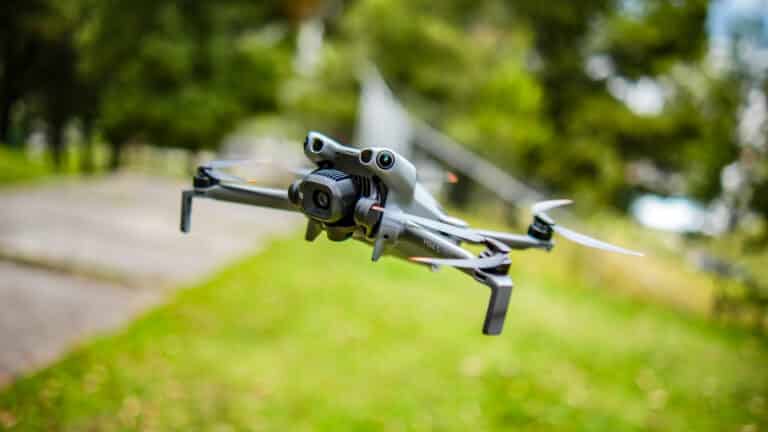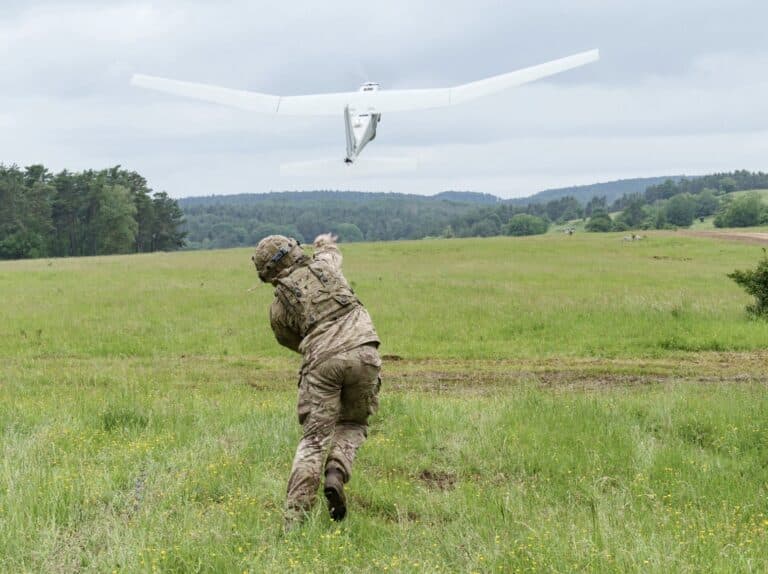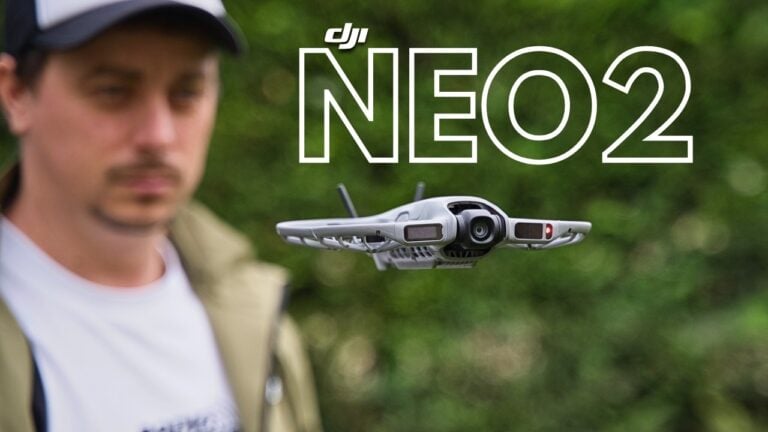UK’s DragonFire Laser Destroys Drones At 404 MPH In Historic Test

Amazon Drone Deals: DJI Mini 5 Pro Fly More Combo with DJI RC2 now for $1,099!
The United Kingdom just proved laser weapons are no longer science fiction.
Britain’s DragonFire laser system destroyed high-speed drones traveling at 650 km/h (404 mph) during live trials at the MOD Hebrides range in Scotland. The successful tests triggered a £316 million ($413 million) contract to deploy the weapon on Royal Navy warships by 2027.
This marks a watershed moment for NATO’s counter-drone capabilities. DragonFire becomes the first high-power laser weapon entering operational service from a European nation.
What DragonFire Achieved
The recent trials weren’t just impressive. They were historic.
DragonFire tracked, targeted, and destroyed drones flying twice the top speed of a Formula 1 car. The system achieved the UK’s first above-the-horizon laser intercept, engaging targets at extended ranges that previous tests hadn’t attempted.
Engineers say the laser can hit a £1 coin from a kilometer (0.6 miles) away.
That precision comes cheap. Each shot costs approximately £10 ($13), compared to hundreds of thousands of pounds for traditional missile interceptors. When a single Sea Viper missile can cost over $1 million, the economics become obvious.
Defence Minister Luke Pollard called it a “truly game-changing weapon system” that will place the Royal Navy “at the leading edge of innovation in NATO.”
How The System Works
DragonFire uses a British-developed beam-combining method that merges multiple fiber lasers into a single concentrated beam. The system sits in the 50-kilowatt class, powerful enough to burn through drone structures in seconds.
The weapon mounts on a rotating turret alongside electro-optical cameras and a tracking laser.
When the ship’s radar detects a threat, the combat management system hands off targeting data to DragonFire. The beam travels at the speed of light, eliminating the need to lead fast-moving targets like conventional guns require.
The real advantage is ammunition. A warship carries limited missiles. DragonFire fires as long as power and cooling hold steady.
That means a destroyer can engage dozens of cheap drones without depleting its stockpile of expensive missiles needed for larger threats.
Deployment Timeline
MBDA UK leads the program alongside partners QinetiQ and Leonardo. The £316 million contract covers two DragonFire installations on Type 45 destroyers, with the first ship fit scheduled for 2027.
That’s five years ahead of the original schedule.
The accelerated timeline reflects Europe’s urgent need for cost-effective counter-drone solutions. Russian drone attacks on Ukraine have demonstrated that cheap unmanned systems can overwhelm expensive air defenses through sheer volume.
The UK’s Strategic Defence Review backed directed energy weapons with nearly £1 billion in additional investment this parliamentary term. Officials say the contract will create and sustain 590 jobs across Scotland, the southwest, and eastern England.
MBDA UK Managing Director Chris Allam said the contract “re-affirms the UK’s intent to be at the forefront of laser directed energy weapons.”
The Global Laser Arms Race
Britain isn’t alone in pursuing directed energy solutions.
Israel’s Iron Beam system has already proven its worth in combat, destroying dozens of Hezbollah drones during the ongoing Middle East conflict. That marked the world’s first operational use of a laser weapon to shoot down drones in actual warfare.
The U.S. Army recently tested its DE M-SHORAD system at Fort Sill, Oklahoma, mounting 50-kilowatt lasers on Stryker vehicles. The Pentagon invests approximately $1 billion annually in directed energy development.
Australia’s Electro Optic Systems is marketing its 100-kilowatt Apollo laser to NATO members, claiming it can neutralize up to 20 drones per minute at less than 10 cents per shot.
Germany’s Rheinmetall has tested counter-drone lasers for the Bundeswehr. China is reportedly developing drone-mounted systems that redirect ground-based laser beams onto targets.
The race is accelerating because the threat demands it.
Why Lasers Matter Now
Modern battlefields have exposed a brutal economic reality.
Ukraine faces nightly attacks from Russian drones that cost as little as $10,000 each. Defending with missiles that cost $1 million or more is mathematically unsustainable. Russia can manufacture 75,000 Shahed-style drones annually. No missile stockpile can keep pace.
DragonFire and similar systems flip that equation.
A laser draws power from the ship’s generators. It doesn’t run out of ammunition. It costs pennies per shot. A destroyer equipped with DragonFire can engage swarm after swarm without exhausting its defenses.
The limitations are real. Rain, fog, and sea spray reduce beam effectiveness. Heavy waves make sustained targeting difficult. But the Royal Navy believes DragonFire has matured enough to overcome maritime challenges.
DroneXL’s Take
DragonFire represents exactly what Western defense procurement should look like: rapid development, accelerated timelines, and technology that actually addresses modern threats.
The contrast with Europe’s bureaucratic struggles couldn’t be sharper. As we reported in October, the EU’s drone wall initiative has stalled as France and Germany block progress over political turf wars. Meanwhile, Britain just committed nearly half a billion dollars to operational laser weapons.
The economics tell the story. We’ve covered how NATO members are scrambling to find affordable counter-drone solutions after watching Ukraine defend against attacks that would bankrupt traditional missile-based systems. DragonFire’s $13-per-shot cost isn’t just cheaper. It’s transformational.
Israel showed the way first. As we reported in June, Iron Beam became the world’s first laser to shoot down drones in combat, destroying Hezbollah UAVs at roughly $2.50 per engagement. DragonFire brings that capability to naval platforms where traditional defenses are even more constrained by magazine depth.
The broader pattern is unmistakable. Ukraine has emerged as NATO’s drone warfare teacher, with three years of brutal combat experience reshaping how Western militaries think about unmanned threats. The UK’s Project OCTOPUS already mass-produces Ukrainian interceptor drones. DragonFire adds another layer to a defense ecosystem being rebuilt from the ground up.
The real test comes at sea. Salt spray, rolling decks, and unpredictable weather will challenge systems that performed well on Scottish ranges. But if DragonFire proves reliable in operational conditions, it could force every navy and adversary to rethink how they approach drone warfare.
Britain is betting that directed energy weapons represent the future of close-in defense. Given the alternatives, that’s a smart wager.
What do you think? Share your thoughts in the comments below.
Discover more from DroneXL.co
Subscribe to get the latest posts sent to your email.
Check out our Classic Line of T-Shirts, Polos, Hoodies and more in our new store today!

MAKE YOUR VOICE HEARD
Proposed legislation threatens your ability to use drones for fun, work, and safety. The Drone Advocacy Alliance is fighting to ensure your voice is heard in these critical policy discussions.Join us and tell your elected officials to protect your right to fly.
Get your Part 107 Certificate
Pass the Part 107 test and take to the skies with the Pilot Institute. We have helped thousands of people become airplane and commercial drone pilots. Our courses are designed by industry experts to help you pass FAA tests and achieve your dreams.

Copyright © DroneXL.co 2025. All rights reserved. The content, images, and intellectual property on this website are protected by copyright law. Reproduction or distribution of any material without prior written permission from DroneXL.co is strictly prohibited. For permissions and inquiries, please contact us first. DroneXL.co is a proud partner of the Drone Advocacy Alliance. Be sure to check out DroneXL's sister site, EVXL.co, for all the latest news on electric vehicles.
FTC: DroneXL.co is an Amazon Associate and uses affiliate links that can generate income from qualifying purchases. We do not sell, share, rent out, or spam your email.


















